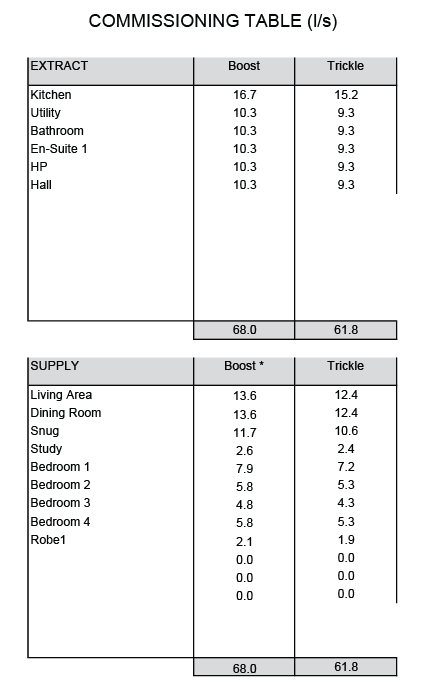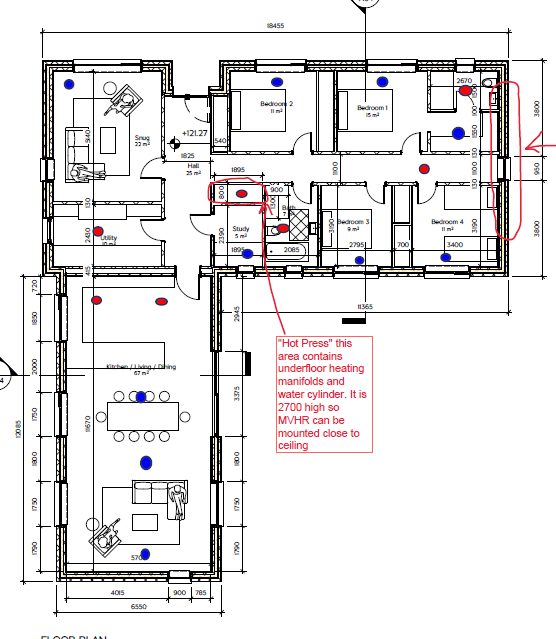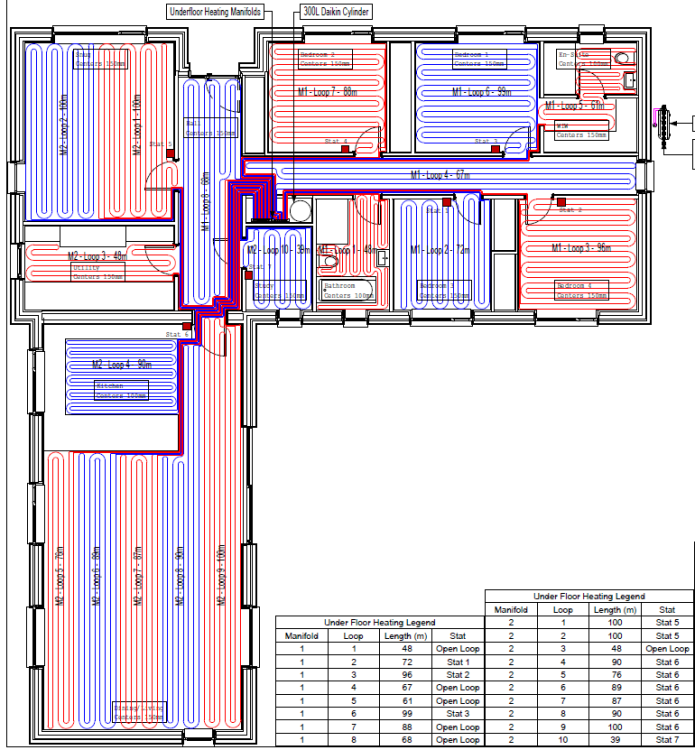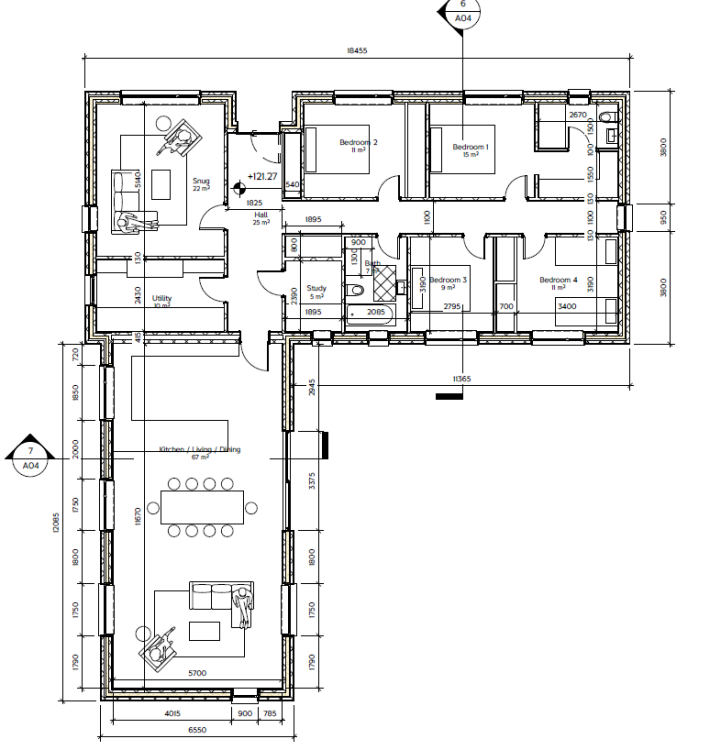
umiq88
Members-
Posts
33 -
Joined
-
Last visited
Everything posted by umiq88
-
MVHR Design Feedback
umiq88 replied to umiq88's topic in Mechanical Ventilation with Heat Recovery (MVHR)
Thanks @JohnMo - Spiral only for Main ducts, Radial semi-rigid plastic to each room. - I spoke with vendor and he designs for 10l/s per valve. Kitchen Extract is 15l/s hence 2 valves. Supply is same story. - The hall extract is there to balance the system. There is not enough wet rooms to meet the 61.8l/s requirement. Its in the hall for want of a better place. -
Hi All, I've got a couple of quotes and below is what I feel is the most through. Floor Area is 206m2 and design flow is 61.8l/s. Supply and Extract runs are around 13m so going to use 200mm spiral duct to keep velocities low. Haven't calculated duct losses yet but will be installing 90mm valves and hopefully one pipe to each. Supplier says to keep each valve below 10l/s this is why there is 3 supplies and 2 extract in the open plan area. Any comments greatly appreciated.
-
Thanks for all the advice here. Slab is 75mm Cemfloor which is cement based screed. My thoughts were you need enough volume and surface area in the system to keep the heat pump temp down and avoid it cycling. I’d prefer not have a second pump as I’m trying to keep it to a minimum of components. @JohnMo I get your approach but do you see a downside other than the. Maybe pressure loss and materials to additional pipe work?
-
Thanks everyone for the replies. Yes seems to be a lazy generic design. House is new build and spec is following 206sqm U values are 0.15 - External Walls - 110mm cavity PIR and 50mm insulated plasterboard on external walls(37.5+12.5) 0.12 - Floor - 150mm PIR 75mm screed 0.13 – Roof – 400mm Rockwool or 200mm PIR 0.7 – Windows 1.4 – Doors I'm wiring myself so won't be putting in the stats but is there a downside to the closer pipe centres? Would turning down the flowrate have the same impact as larger spacing. I do want to make sure I have lowest flow temp possible in order to get max efficiency. Heat pump will be Daikin 8kW What questions would you ask or how would you go back to supplier to improve design.
-
-
In the process of wiring and getting UFH installed in a couple of weeks. Layout is 4 bed Bungalow and wondering about theromstats Plan is to have everything except the bedrooms on 1 zone and 1 thermostat per bedroom. The whole system should work off weather compensation but I want the option to have the bedrooms a little colder if need be or I have an older person in the family staying over. Where is the best location for the main thermostat controlling the whole house?
-
Like this. Only white pipe will be run internally and come out through external wall straight into boss pipe. It will have to go above the slab in the insulation layer. Below that and it would penetrate the radon.
-
Based in Ireland. Thanks Temp that's very helpful. This is bungalow so everything is ground floor. I've checked dimensions for toilet so ok with that. For 40/50mm pipes into gulley what height do you normally go through the wall at. Do you have a link to a gulley you normally use? My floor is made up of 75mm Screed, 150mm PIR, 100m Sub Floor Slab, 25mm Sand Blinding, 200mm Compacted Rock
-
No BC over here for self builds. I've attached a copy of the plans to give you and idea. Would you run one 110mm pipe into each bathroom and pipe the white wastes into that or should I have a 110mm coming up through the slab under each drain (sink, shower, bath etc) Wastewater treatment is located at the top right 10m away.
-
Looking for some help. Have foundations down and starting dead work. Will soon be laying soil and waste water pipes. Bath and Shower will be 50mm and sinks will be 40mm. Plan is to bring them individually down through slab and out through external wall into back inlet gulley trap. Is the height of the pipes critical. I have not done this before and wondering if the connection into the BIGT is adjustable or fixed height. Photos or a sketch would be fantastic.
-
Thanks after it bit of research looks to be a good unit. My only concern not knowing much about split units it - If gas is removed how easy is it for parts to become damaged from moisture. - I won't be installing for a year or so can these be stored properly dry or what would be the best way. Also any considerations for transport?
-
@Russell griffiths If the pipes start in the house, go up into the attic and then back down into the house then you create a pocket for air to gather. On a conventional gravity fed system this would air lock and you would either get no flow or reduced flow. I have not lived in or worked on many pressurised systems. Surely the same problem exists unless the pressure is enough to drive water through the system.
-
My cylinder and manifolds will be in the house. How do you deal with air in the pipes? Jenki makes a good point about air tightness which can be solved but is another consideration.
-
Originally looking at Grant (Chofu) 6kW unit but found a Hitachi at good price. Indoor Unit RWD-2.5RW1E-220S Outdoor Unit RAS-2.5WHVRP1
-
Thanks guys Location of UVC is a 800x1900 cupboard in the hall. Plan to make floor lower and put in floor drain. All CH and DW pipes etc will come from here and can be isolated and drained down. Looks like conduit in the floor solves all problems. Build is normal bungalow no upstairs. Attic vented to outside. Cabling will be chased into walls and go up to attic but will have to think about how to seal. Same for penetrations around lights.
-
New build looking to install mains water and UVC centrally and run piping through attic to kitchen, WCs etc. In my head sounds like a great idea for access, maintenance etc. however thinking about it am I going to need a air vents on every line or will a pressurised system push the air out?
-
Just an estimate when I got pricing. Haven't done calc yet. Anyone have any recommendations for easy to use calculator? Not sure on air tightness either. Will be going highest practical.
-
New build bungalow 200sqm all UFH. 150mm PIR in floor with 75mm screed, 110mm PIR in cavity with 50mm insulated plasterboard on internal block wall. Originally plan was oil boiler but after pricing everything ASHP is starting to make sense with 7-8year pay back. Also much simpler. Looking for some help with design. This will be self install hence all the questions. Grant Aerona3 (Chofu) 10kW (subject to heat loss calc) Inverter driven and variable flowrate/output temp etc. Grant 300l UVC 2.35m2 area coil. Open to recommendations as the coil seems small. Couple of questions - Do you still need red expansion vessel on low temp system? - On oil boilers is standard to install likes of Spira vent and trap. Is this needed? - What is the best way to plumb UVC coil? Presume a 3 port mixer but how is this typically controlled. - There will be no zoning on UFH just weather comp on ASHP. However main areas are recommended at 20 and bedrooms at 18. How is this achieved? Balancing?? - 16mm pex-al-pex in floor with 150mm spacing. Presume spacing is not that important but 150mm is standard. - 32mm pex-al-pex between ASHP and manifolds. Use water and frost valves. - No buffer/volumizer etc. What do people do for control. I'm based on Ireland so the likes of homely isn't available. Do people just set a weather curve and keep adjusting until optimal or is there a better way to approach. Heatpump has modbus.
-
Thanks for advice. I'll go away and do my research. is there a couple of main manufacturers I should be looking at. Quick look on ebay has this air source heat pump Daikin 6KW OUTDOOR UNIT | eBay
-
Based in Ireland new build with 206sqm underfloor and 300l UVC. Originally looking to install oil boiler but doing the maths if I can get a Heat Pump for the right price it could work out better. Plus much similar to install no mixers all 1 zone etc. I hear of several people getting good deals off ebay. Are there certain brands to avoid, does sCOP vary much from 1 manufacturer to another? For example I can source a BC15-012S/P locally for just over 1k. China Household 3.8~9.8kW Air to Water Heat Pump Water heater for Domestic Hot Water BC15-008S/P~020S/P Manufacturer and Supplier | O.S.B. (osbheatpump.com) Need a sCOP of 2.6 to break even will current oil/electricity prices and I can buy all materials for approx €1500.
-
New Build 150mm PIR in floor and 130mm PUR in wall. @Conor what setup would you recommend to prevent short cycling and keep return temps right? @Andehh what thermostats/controller are you using.
-
Does anyone have a good design guide or insight on the best way to setup UFH and what the best controls are? 2 manifold system individual mixers fed from oil fired boiler with 100l buffer. Ideally I would like to be able to set lower temperatures in the bedrooms and lower the setpoint at night. The only point would be to reduce costs. Ideally would like each room zone and to be able to control thermostats centrally via a web browser or app. Is there an off the shelf solution for this? Something similar to a Hive for conventional system.
-
Thanks ETC that's very helpful. What are the BIGT? For the drains from sink bath etc I was going to use the detail below. I don't have any stud partitions to pipes in so was going to run 110m drain to each point. From reading regs I need to make sure there is at least 450mm from connection to drain and invert so I suppose that will set my level and I will install the treatment system as required by pipe falls. Photo source site: buildhub.org.uk soil pipe screed - Google Search
-
Thanks Dave, Yes new build. My thoughts were to bring the pipes straight out to minimise pipes under the foundation where I can't get to them. Also I was advised to bring washing machine and kitchen through a grease trap before entering the treatment plant. Does it matter where in the 'circuit' I connect the stack? There will be no drains into it just a vent.
-
Question regarding pipes sizing. Central heating will be 35mm between ASHP and manifolds and 16mm Pex in the floor. Water supply is submersible well. I was going to use 32mm MDPE into the house. System will be fed directly from pump no tank in attic. What size pipes to the hot water cylinder (300l unvented). Was going to use 16mm to kitchen. There are 2 bathrooms 1. Bath, shower, sink and toilet approx 4-5m from cylinder 2. Shower, sink and toiler appox 18m from cylinder I want good flow and pressure but I don't want to be waiting for every to run off cold lines. Dont want a recirc system. Would 16mm be enough to both bathrooms with a second separate 16mm connection to the bath?




